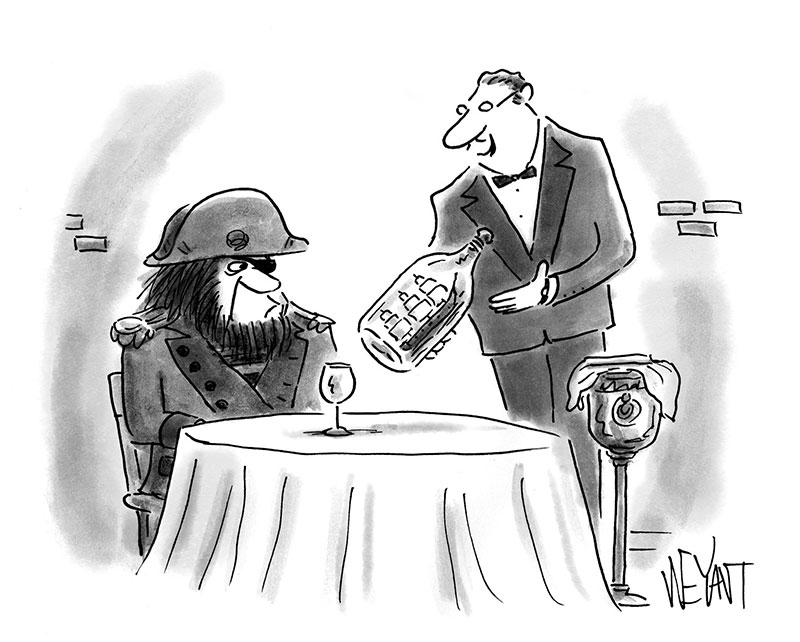 Chris Weyant’s cartoon is set in a fine restaurant, where a pirate is dining alone. A sommelier is presenting a ship in a bottle as if it were a bottle of wine. In front of the pirate is an empty wine glass. The sommelier is speaking.
Chris Weyant’s cartoon is set in a fine restaurant, where a pirate is dining alone. A sommelier is presenting a ship in a bottle as if it were a bottle of wine. In front of the pirate is an empty wine glass. The sommelier is speaking.
Some wines are described as spicy, and Old Spice is a brand that used seafaring images in its advertising campaigns from the ‘70s—I don’t know how or when I learned that Matthew Perry’s father played the clean shaven sailor in the TV commercials, but I have for some reason retained this information—so I thought of this caption: “It’s Old-Spicy.”
Other wines are described as oaky, and because sailing vessels were made from hardwoods like oak, I thought of these captions:
- “It’s very oaky.”
- “More than a hint of oak.”
My final caption has the wine steward describing the bottle’s contents in a pretentious manner that’s typical of the way sommeliers, or at least the ones who appear in cartoons, talk: “Your tongue may detect a salty flavor.”
Now let’s see how you did:
There were a lot of puns that played on the double meaning of the word “port,” but these two were the best:
- “Can I interest you with something in a Port?”
- “This pairs well with a nice port.”
Like that second caption, the next two entries refer to the way wine stewards suggest pairings:
- “This one pairs well with albatross.”
- “May I suggest pairing it with an Impossible Burger?”
I love that last caption because impossible burgers exist—they’re made with plant-based ingredients—and a ship in a bottle is the traditional example of an “impossible bottle,” which is one containing an object that does not appear to fit through the bottle’s mouth. I know I shouldn’t explain jokes, but I’m not sure “impossible bottle” is a commonly recognized term.
Like I did, several of you referred to an oaky finish, and these were the best two entries:
- “It’s a bit oaky.”
- “You wanted oaky.”
I like slapstick comedy, and these are essentially slapstick captions:
- “I’ll be more careful popping the cork on this one.”
- “We’ll aim the cork away from your eyes this time, sir.”
The image of the sommelier opening the wine bottle and accidentally hitting the pirate in the eye with the cork actually made me laugh out loud.
The next set of captions refer to Spanish and Chinese sailing ships:
- “This wine comes by the galleon.”
- “Would you prefer the half-galleon?”
- “It’s better than that Chinese junk.”
That last caption is especially good because a traditional sommelier might dismiss Chinese wines as inferior to French and Italian varieties.
I like the way this next entry plays on the double-meaning of a word for another kind of sailing ship: “Or perhaps you would like a schooner of beer?”
I’m on the fence, however, about these next two captions:
- “You wouldn’t want it on the rocks, would you?”
- “On the rocks?”
The expression “on the rocks” has a double-meaning that works well in the context of sailing ships and alcohol, but wine is, to the best of my knowledge, never served over ice cubes. On the other hand, it is sometimes chilled and I don’t know much about wine, so if I got this wrong I apologize to the people who submitted those two captions.
This is a nice reference to the practice of letting red wine aerate for a short time before drinking it: “Shall I let them breathe?” The implication that the ship is full of tiny people who are suffocating or drowning gives the cartoon a dark edge, like something that Charles Addams or Gahan Wilson might have drawn.
Here are the week’s two best puns:
- “A little something from the sandbar?”
- “It’s from our craft wine selection.”
And while the following caption is far too long, it made me laugh: “The manager says this is the only thing in a bottle I can offer because of your tendency get all rapey and plundery when you’ve been drinking.”
Finally, here‘s a clever reference to both the number of sails on the ship and a common way of describing someone who’s drunk: “How about nine sheets to the wind?” I always liked but never understood the phrase “three sheets to the wind,” so I checked its etymology—I sound as pretentious as a sommelier—and discovered that it’s a matter of some controversy.
Here’s the explanation I like best, and it comes from a Letter to the Editor that the New York Times published on December 12, 1994: Robert A. Di Curio wrote, The true origin of “three sheets to the wind” was disclosed to me by a Nantucket sailor. Four sheets to the wind are O.K. because they are balanced. So are two sheets now and then. But three? Never. The old Dutch-style windmill on Nantucket Island in Massachusetts . . . has four wooden vanes to which are attached four sails — or more properly, sheets. If the miller leaves one off, only three are presented to the wind. The mechanism is then severely out of balance, and in a fresh breeze the entire structure of the mill goes into a violent and potentially destructive shudder, evoking the image of a staggering drunk.
Now, back to the contest. Much as I like the “Impossible Burger” entry—it’s really clever—and even though the “cork in the eye” captions made me laugh, I’m going with, “It’s better than that Chinese junk.”

